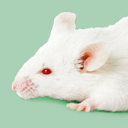Description
forkhead box P2 [Source:MGI Symbol;Acc:MGI:2148705]
Gene Synonyms
2810043D05Rik, AI449000, CAG-16, D0Kist7
Location
Chromosome 6: 11,896,907-12,157,869 forward strand.
Reference strain equivalent
About this transcript
This transcript has 18 exons, is annotated with 27 domains and features and maps to 191 oligo probes.
Gene
This transcript is a product of gene MGP_BALBcJ_G0030446.1 Show transcript tableHide transcript table
| Transcript ID | Name | bp | Protein | Translation ID | Biotype | CCDS | UniProt Match | Flags |
|---|---|---|---|---|---|---|---|---|
| MGP_BALBcJ_T0076357.1 | - | 2543 | 739aa | MGP_BALBcJ_P0076357 | Gene/transcipt that contains an open reading frame (ORF).Protein coding | - | A single transcript chosen for a gene which is the most conserved, most highly expressed, has the longest coding sequence and is represented in other key resources, such as NCBI and UniProt. This is defined in detail on http://www.ensembl.org/info/genome/genebuild/canonical.htmlEnsembl Canonical, | |
| MGP_BALBcJ_T0076349.1 | - | 6765 | 714aa | MGP_BALBcJ_P0076349 | Gene/transcipt that contains an open reading frame (ORF).Protein coding | CCDS19918, CCDS71726 | D3YUM2 D3YUQ7 D3Z142 D3Z146 D3Z2Q6 D3Z4F4 D3Z7E9 F6UMM1 P58463 Q3TPK1 | - |
| MGP_BALBcJ_T0076356.1 | - | 5651 | 714aa | MGP_BALBcJ_P0076356 | Gene/transcipt that contains an open reading frame (ORF).Protein coding | - | - | |
| MGP_BALBcJ_T0076355.1 | - | 2692 | 83aa | MGP_BALBcJ_P0076355 | Gene/transcipt that contains an open reading frame (ORF).Protein coding | - | - | |
| MGP_BALBcJ_T0076358.1 | - | 2686 | 693aa | MGP_BALBcJ_P0076358 | Gene/transcipt that contains an open reading frame (ORF).Protein coding | - | - | |
| MGP_BALBcJ_T0076363.1 | - | 1381 | 456aa | MGP_BALBcJ_P0076363 | Gene/transcipt that contains an open reading frame (ORF).Protein coding | - | - | |
| MGP_BALBcJ_T0076364.1 | - | 1293 | 430aa | MGP_BALBcJ_P0076364 | Gene/transcipt that contains an open reading frame (ORF).Protein coding | - | - | |
| MGP_BALBcJ_T0076362.1 | - | 792 | 260aa | MGP_BALBcJ_P0076362 | Gene/transcipt that contains an open reading frame (ORF).Protein coding | - | - | |
| MGP_BALBcJ_T0076359.1 | - | 777 | 171aa | MGP_BALBcJ_P0076359 | Gene/transcipt that contains an open reading frame (ORF).Protein coding | - | - | |
| MGP_BALBcJ_T0076352.1 | - | 647 | 86aa | MGP_BALBcJ_P0076352 | Gene/transcipt that contains an open reading frame (ORF).Protein coding | - | - | |
| MGP_BALBcJ_T0076368.1 | - | 2762 | 56aa | MGP_BALBcJ_P0076368 | Nonsense mediated decay | - | - | |
| MGP_BALBcJ_T0076351.1 | - | 2850 | No protein | - | Gene/transcript that doesn't contain an open reading frame (ORF).Processed transcript | - | - | |
| MGP_BALBcJ_T0076367.1 | - | 407 | No protein | - | Gene/transcript that doesn't contain an open reading frame (ORF).Processed transcript | - | - | |
| MGP_BALBcJ_T0076354.1 | - | 349 | No protein | - | Gene/transcript that doesn't contain an open reading frame (ORF).Processed transcript | - | - | |
| MGP_BALBcJ_T0076365.1 | - | 265 | No protein | - | Gene/transcript that doesn't contain an open reading frame (ORF).Processed transcript | - | - | |
| MGP_BALBcJ_T0076350.1 | - | 2877 | No protein | - | An alternatively spliced transcript believed to contain intronic sequence relative to other, coding, transcripts of the same gene.Retained intron | - | - | |
| MGP_BALBcJ_T0076361.1 | - | 2103 | No protein | - | An alternatively spliced transcript believed to contain intronic sequence relative to other, coding, transcripts of the same gene.Retained intron | - | - | |
| MGP_BALBcJ_T0076353.1 | - | 1770 | No protein | - | An alternatively spliced transcript believed to contain intronic sequence relative to other, coding, transcripts of the same gene.Retained intron | - | - | |
| MGP_BALBcJ_T0076366.1 | - | 1178 | No protein | - | An alternatively spliced transcript believed to contain intronic sequence relative to other, coding, transcripts of the same gene.Retained intron | - | - | |
| MGP_BALBcJ_T0076360.1 | - | 6196 | 700aa | MGP_BALBcJ_P0076360 | Unknown likely coding | - | - |

